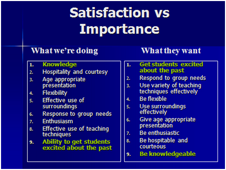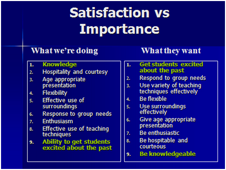
Today’s guest post is by Conny C. Graft, a consultant in research and evaluation based in Williamsburg, Virginia. Her keynote on the future of museum audiences, delivered at the Small Museums Association Conference this past spring received rave reviews, so I invited her to share her musings on the CFM Blog.
I recently conducted a post-field trip survey with school teachers about the skills of interpreters,asking the teachers to rank a list of critical skills that the interpreters demonstrated from best to worst. I also asked the teachers to use the same list to rank which skills were most important to the success of a field trip. The good news: teachers ranked interpreters most highly on knowledge. The bad news: knowledge was the least valued of the listed skills. The teachers indicated the most important skill for the success of a field trip was the ability to get students excited about the subject, and on this skill interpreters ranked dead last.
(The left column shows the best to worst skills teachers believed the interpreters exhibited. The right column shows the skills that were most important to them. These are the skills they hoped for and felt would make the field trip useful and memorable.)
When I shared the results with interpreters, some were visibly confused. Why wouldn’t teachers rank knowledge as the most important skill? Because teachers want to spark their student’s interest so that they go back to the classroom excited about learning history. Is it possible this opportunity to become enthused about a subject is what is most important to other visitors as well? More generally, do historians, curators, visitor services staff, directors and board members assume that visitors value knowledge over the ability of staff to engage the interest of their audience? Do staff, in effect, assume that visitors are mirror-images of themselves?
As a visitor researcher, evaluator and trainer, I spend a lot of time thinking about how to make museums sustainable. Several recent CFM reports examine the changes in American demographics. In 2010, there was “Museums and Society: 2034,” followed by “Demographic Transformation and the Future of Museums” (prepared for CFM by the Cultural Policy Center of The University of Chicago). These reports make it clear that in the U.S. minorities are growing relative to overall population, and museums need to consider the impact of this change. This past May at the AAM annual meeting, I attended a presentation by James Chung from Reach Advisors where he shared recent Census Bureau data. There it was again: the changing face of America. When I looked around the room at the audience, there we were: all white and almost all female. But the gap in diversity between staff and audiences goes beyond white/nonwhite and male/female.We need to examine the assumptions we make about current and future audiences, and how these assumptions are shaped by the demographics of our staff and volunteers. Do visitors in fact value what we value? Do they want to consume what we want to provide, in the way we prefer to provide it?
The field trip story I relate above suggests that the gap between “us” and “them” may deep. This is born out by my overall experience as a consultant. Recently, before giving a talk for interpreters for The Historic Homes Consortium of Washington, D.C., I surveyed interpreters and guides registered for the symposium on how they preferred to experience historic sites and houses. During my talk I shared the results of their surveys and compared them to the results of a larger study, conducted by Reach Advisors, which asked museum visitors how they prefer to visit historic sites. As I expected, while most interpreters preferred guided tours, only half of visitors do so. The other half of visitors preferred to see sites on their own. While most of the interpreters did not prefer hands-on activities, a large majority of visitors do, especially families with children. Understanding and examining our own biases and preferences for learning and identifying where they are similar or different to those of our audience is critical to preparing our staff and volunteers for change.
Museums may need assistance in recognizing our assumptions and considering how they impact visitors. The Arc of Dialogue method has been used successfully at many institutions, including many Civil Rights Sites of Conscience (The Lower East Side Tenement Museum, The Levine Museum of the New South, The Wing Luke Museum, the Jane Adams Hull House Museum and others) to bring visitors together to talk about difficult issues. Perhaps we could we use this tool with our staff and volunteers to examine stereotypes and assumptions about our current and potential audiences.
Examining internal assumptions amongst staff/volunteers before undertaking a visitor study can be eye opening. After the visitor study is complete compare the findings to your initial assumptions. Do staff and volunteers think that the visitors they serve share their values and preferences? If the visitor study challenges those assumptions, how might this realization change how you select and train interpreters? Would it change how you design the museum experience? We may think that our visitors mirror ourselves, but visitor studies can help us really see who we are serving, and identify, understand and bridge the gaps between our assumptions about our audienceswhat they truly want and need.









Connie's blog points out the role of skillfully designed and conducted visitor studies! What a great approach to provokes further questioning and reflection among staff to make connections to audiences. Museums have such an important role to play in people's lives and one of those roles is putting the pleasure and joy back into learning.
I can't read that image! 🙁 too small to see the columns
Thanks for your comment Justme…and to CCHA…send me your email and I will send you that image in a larger format. Conny
I would like a larger image, too. My email is hkearns@tscpl.org. Thanks so much!
Please send us the image in larger format as well. We found this post very intriguing! Thank You!
henriquez@chicagohistory.org
Me too, please. The details are important. erodley at mos dot org.